Computing Essentials 2
计算机专业英语2013影印版课后答案(ComputingEssentials2013)选择题

计算机专业英语2013影印版课后答案(ComputingEssentials2013)选择题计算机专业英语2013影印版课后答案(Computing Essentials 2013)选择题Multiple 11. The keyboard, mouse, monitor, and system unit are:hardware output devices storage devices software2. Programs that coordinate computer resources, provide an interface, and run applications are known as:application programs operating systemsstorage systems utility programs3. A browser is an example of a:basic application specialized programsystem application utility program4. Although not as powerful as a supercomputer, this type of computer is capable of great processing speeds and data storage.mainframe media center midrange netbook5. The smallest type of microcomputer:netbook handheld midrange tablet PC6. RAM is a type of:computer memory network secondary storage 7. Unlike memory, this type of storage holds data and programs even after electrical power to the computer system has been turned off.primary RAM ROM secondary8. The type of file created by word processors to save, for example, memos, term papers, and letters.database document presentation worksheet9. The change in connectivity that uses the Internet and the Web to shift many computer activities from a user’s comput er to computers on the Internet.cloud computing high definition network USB10. The largest network in the world is [the]:Facbeook Internet Web USBMultiple 21. The network that connects computers all over the world.CERN Internet LAN Web2. The rules for exchanging data between computers.DSL protocols Web WWW3. Client-based e-mail accounts require this special program to be installed on your computer.e-mail client hyperlink Java utility4. Communities of individuals who share a common interest typically create Facebook:clients groups pages profiles5. E-mail that does not require an e-mail program installed on a user's computer is known as:blog podcast Webmail utility6. A very well-known microblog.LinkedIn MySpace Twitter Wikipedia7. These programs continually look for new information and update search services’ database programs.filters IM spiders wikis8. A type of search engine that submits requests to other search engines, organizes their responses, eliminates duplicate responses, orders hits, and then provides an edited list.directory search ISPmetasearch engine specialized search engine9. This is th e Internet’s equivalent to traditional cash.digital cash e-commerce icash Internet dollars 10. Using file transfer utility software, you can copy files to your computer from specially configured servers on the Internet. This is called:downloading filtering blogging uploadingMultiple 31. This type of software works with end users, application software, and computer hardware to handle the majority of technical details.application general purpose system utility2. A rectangular area that can contain a document, program, or message.dialog box form frame window3. Programs that create text-based documents.DBMS suites spreadsheets word processors 4. Programs that organize, analyze, and graph numeric data such as budgets and financial reports.DBMS suites spreadsheets word processors5. In a spreadsheet, the intersection of a row and column creates a:cell formula function label6. A collection of related data that is the electronic equivalent of a file cabinet.cell database document table7. A database tool that will quickly rearrange a table’s records according to a selected field.filter sort spreadsheet word processor8. Programs that combine a variety of visual objects to create attractive, visually interesting presentations.DBMS presentation graphics spreadsheet word processor 9. The primary disadvantage of this type of package is that the capabilities of each function are not as extensive as in individual programs.integrated office software utility10. A type of suite stored at a server on the Internet and available anywhere through Internet access.cloud integrated office utilityMultiple 41. These specialized graphics programs combine text and graphics to create publications of professional quality.desktop publishing programs image editorsimage galleries illustration programs2. Also known as drawing programs.desktop publishing programs image editorsimage galleries illustration programs3. Graphics programs used to create and edit vector images.desktop publishing programs image editorsimage galleries illustration programs4. An essential multimedia feature that allows user participation.Flash interactivity immersion raster5. Special programs used to create multimedia presentations.desktop publishing programs Flash editorsimage editors multimedia authoring programs 6. A widely used interactive animation application from Adobe.ACTION Flash Fuzzy WYSIWYG7. Programs for Web site design and HTML coding are called Web page editors orapps HTML editors VR programs Web editors8. This area of artificial intelligence is also known as expert systems.acoustics knowledge-based systems robotics virtual reality 9. A type of artificial intelligence that uses a database to provide assistance to users.acoustics expert systems robotics virtual reality 10. Another name for the database used in expert systems that contains specific facts and rules.access table expert table knowledge base rule baseMultiple 51. What type of software works with users, application software, and computer hardware to handle the majority of technical details?dapplication desktop Linux system2. The programs that convert programming instructions written by programmers into a language that computers understand and process are language: converters linguists managers translators3. The ability to switch between different applications stored in memory is called:diversion multitasking operational interference programming 4. Graphic representations for a program, type of file, or function: app icon image software5. This operating system feature is controlled by a mouse and changes shape depending on its current function.dialog box menu mouse pointer6. The operating system based on Linux, designed for Netbook computers, and focused on Internet connectivity throughcloud computing:Chrome Mac Unix Windows7. The mobile operating system developed by Apple and originally called iPhone OS:Android BlackBerry OS IOS Mac OS8. A utility program that makes copies of files to be used in case the originals are lost or damaged:Backup and Restore Disk Cleanup Disk Defragmenter Compactor 9. A troubleshooting utility that identifies and eliminates nonessential files, frees up valuable disk space, and improves system performance:Backup and Restore Disk Cleanup Disk Defragmenter Compactor 10. Windows makes it easy to update drivers with Windows:Backup Restore Driver UpdateMultiple 61. This container houses most of the electrical components for a computer system.carrier package system board system unit TV tuner2. Similar to notebooks, this system unit specializes in on-the-go Web browsing and e-mail access.chassis desktop media center netbook3. Computers can only recognize this type of electronic signal.analog bus digital maximum4. The main or motherboard is also known as the:computer board processor mobile system system board 5. How many bytes can a 32-bit-word computer access at one time?1 48 166. In a microcomputer system, the central processing unit is contained on a single:bus chip module RAM7. This type of memory divides large programs into parts and stores the parts ona secondary storage device.direct expanded random-access virtual8. Also known as NIC, this adapter card is used to connect a computer to a:AIA expansion graphics network9. This provides a pathway to connect parts of the CPU to each other.bus Plug and Play wired wireless10. Older ports that have largely been replaced by faster, more flexible ports are called:buses expandable legacy renderedMultiple 71. Most keyboards use an arrangement of keys known as:Alpha Daisy OptiKey QWERTY2. The device that controls a pointer displayed on the monitor.cord mouse printer scanner3. Also known as a roller ball, this device controls the pointer by rotating a ball with your thumb.trackball joystick cordless mouse stylus4. The type of screen that can be touched with more than one finger and supports zooming in and out by pinching and stretching your fingers.digital dynamic multitouch OLED5. Flatbed and document are types of:headsets HDTVs monitors scanners6. Device used by banks to automatically read those unusual numbers on the bottom of checks and deposit slips.MICR FDIC OMR UPC7. The most widely used audio-input device.mouse VR microphone TFT8. The monitor feature that specifies how often a displayed image is updated.aspect ratio dot pitch refresh rate resolution rate 9. Handheld, book-sized devices that display text and graphics.e-book readers HDTV lasers whiteboards10. This technology allows television stations to broadcast their programming directly to smartphones, computers, and digital media players.CRT HDTV LED Mobile DTVMultiple 81. RAM is sometimes referred to as:primary storage ratio active memoryread only memory secondary storage2. The actual physical material that holds the data and programs.primary storage media disk access3. Measures how tightly these charges can be packed next to one another on the disk.density cylinders tracks sectors4. When a read/write head makes contact with the hard disk’s surface, it causesa head:crash land pit scratch5. This hard-disk performance enhancement anticipates data needs.disk caching file compression file decompression RAID6. This type of storage uses pits and lands to represent 1s and 0s.cloud hard disk optical solid state7. DVD stands for:digital versatile disc digital video datadynamic versatile disc dynamic video disc8. USB drives are also known as:flash drives optical drives ports universal state bus9. An organizational strategy to promote efficient and safe use of data across the networks.cloud dynamic data mission statemententerprise storage system RAID10. A mass storage device that provides access to data archived on tapes.file system NAS RAID system tape libraryMultiple 91. The concept related to using computer networks to link people and resources.connectivity GPS TCP/IP Wi-Fi2. A high-frequency transmission cable that delivers television signals as well as connects computers in a network. coaxial hi def 3-D twisted pair3. A short-range radio communication standard that transmits data over short distances of up to approximately 30 feet. Bluetooth broadband DSL TCP/IP4. The speed with which a modem transmits data is called its:digital velocity dynamic rate modular rating transfer rate5. The bandwidth typically used for DSL, cable, and satellite connections to the Internet.baseband broadband medium band voiceband6. Every computer on the Internet has a unique numeric address called a(n):IP address DNS broadcast packet7. Sometimes referred to as a LAN adapter, these expansion cards connect a computer to a network.PCMCIA NIC server VPN8. A device that allows one LAN to be linked to other LANs or to larger networks.IDS network gateway PAN switch9. Typically using Wi-Fi technology, these wireless access points are typically available from public places such as coffee shops, libraries, bookstores, colleges, and universities.hotspots extranets PANs LANs10. Star, tree, and mesh are three types of network:topologies protocols strategies devicesMultiple 101. The three primary privacy issues are accuracy, property, and:access ethics ownership security2. To easily get names, addresses, and other details about a person using only his or her telephone number, government authorities and others use a(n): adware cookie keystroke logger reverse directory worm3. Browsers store the locations of sites visited in a:history menu tool bar firewall4. The browser mode that eliminates history files and blocks most cookies.detect insert privacy sleep5. The information that people voluntarily post in social networking sites, blogs, and photo- and video-sharing sites is used to create their:access approval firewall online identity phish6. Computer criminals who specialize in stealing, trading, and using stolen credit cards over the Internet are known as: carders card scammers cyber traders identity thieves7. Programs that come into a computer system disguised as something else are called:Trojan horses viruses Web bugs zombies8. The use of the Internet, cell phones, or other devices to send or post content intended to hurt or embarrass another person is known as:cyber-bullying online harassmentsocial media discrimination unethical communication9. Special hardware and software used to con trol access to a corporation’s private network is known as a(n):antivirus program communication gatefirewall spyware removal program10. To prevent copyright violations, corporations often use:ACT DRM VPN WPAMultiple 111. People who react to technology by thinking computers are magic boxes capable of solving all kinds of problems that computers really can’t handle are: cynics frustrated na?ve proactive2. The type of person that looks at technology in a positive realistic way is:cynical proactive na?ve frustrated3. Books, journals, and trade associations are the best sources to help you:develop personal contacts develop specialtieslook for innovative opportunities maintain your computer competency 4. If your career is in marketing, it makes sense to develop a specialty in:database desktop publishingprogramming systems analysis and design5. What computer professional repairs and installs computer components and systems?computer technician data entry workerdesktop publisher software engineer6. What computer professional designs, tests, and researches encryption procedures?cryptographer network administratorprogrammer software engineer7. What computer professional uses database management software to determine the most efficient ways to organize and access data?cryptographer database administratorprogrammer software engineer8. What computer professional oversees the work of programmers, computer specialists, systems analysts, and other computer professionals?information systems manager network managersoftware engineer technical writer9. What computer professional creates, tests, and troubleshoots computer programs?network manager programmersoftware engineer technical writer10. What computer professional plans and designs information systems?network manager programmersoftware engineer systems analyst。
计算机科学导论_Introduction

建立数学模型:将一个现实问题转化成可以被 计算的任务(数学建模)
设计算法:准确而完整地描述可在计算机上执 行的一个求解方案
编写程序或设计硬件逻辑:通过软件或硬件实 现求解方案
可见,软件程序和硬件逻辑都是建立在数 学模型基础上的
计算机科学的数学理论体系
现行教育方式与人工智能学习特点 高度重合
数学之外的理科:
应试教育:注重结论性的东西,忽视问题的提 出、过程的探究、实验设计的原始思路
人工智能:擅长学习已有的知识,在自然问题 和工程问题的提出、探究、实验方面只能起辅 助作用
现行教育方式与人工智能学习特点 高度重合
应试教育正在产生一大批“在思想层面上 类人工智能化,而在执行力层面上远低于 人工智能”的学生:
数值计算:
主要包括数值分析、数学分析、线性代数、计算几 何、概率论与数理统计
离散数学:
一般认为包含集合论、逻辑学、代数学、图论、组 合学
数论:
包括初等数论、解析数论、代数数论、几何数论
计算理论:
主要包括算法学、计算复杂性理论、程序理论
离散数学
离散数学是研究离散量的结构及其相互关系的数 学学科
如何学好数学?
关注数学的来龙去脉,知道数学概念、方法和理论的 产生渊源和发展过程:
它们为什么提出来?要解决什么问题? 理解数学的精神实质和思想方法:
注重思考和理解,不要死记硬背数学知识,要活学要用 对于实际问题要能建立正确的数学模型,然后运用已知的数
学工具加以解决
严格训练,培养抽象思维、逻辑推理和归纳构造能力:
数学是一门关键的技术:
数学的思想和方法与高度发展的计算技术相结合,形成 了一种关键性的、可实现的技术,称为“数学技术”
英语演讲----Database
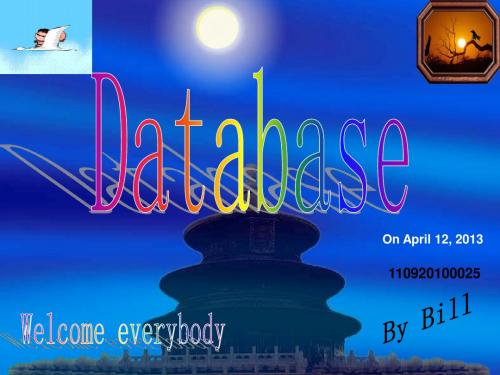
The database operation
Data definition. Defining new data structures for a
database, removing data structures from the database, modifying the structure of existing data. Update. Inserting, modifying, and deleting data. Retrieval. Obtaining information either for end-user queries and reports or for processing by applications. Administration. Registering and monitoring users, enforcing data security, monitoring performance, maintaining data integrity, dealing with concurrency control, and recovering information if the system fails.
What is Database?
A database is an organized collection
of data. The data is typically organized to model relevant aspects of reality (for example, the availability of rooms in hotels), in a way that supports processes requiring this information (for example, finding a hotel with vacancies).
西南大学计算机科学教学大纲

计算机科学与技术专业本科理论课程教学大纲二〇〇九年《计算机科学导论》教学大纲一、课程基本信息课程代码 625040114 课程类别学科基础课程(必修课)中文名称计算机科学导论英文名称Computing essentials适用专业计算机科学与技术专业开课单位计算机与信息科学学院(理论:36 实验实习: 18 ) 学分 3总学时 54先修课程无后续课程高级程序设计、数据结构二、课程性质、地位和任务计算机导论是本学科的专业基础课。
本课程讲授计算机的基本知识、计算机中各种信息码制的表示、计算机系统的基本组成、计算机软件的基础知识、计算机网络的基础知识、Windows操作系统、Office2000办公软件的使用方法等,并提供了软、硬件最新发展动态。
通过本课程的学习,使学生能够熟悉计算机计算机软件、硬件、系统设计,网络应用等各方面的关键概念和术语,掌握一些基本计算机软件的使用和操作,认识基本的硬件设备,了解它们的技术和使用特点,掌握基本的网络应用技巧。
通过本课程的学习为学生构建一个较为完整的计算机科学体系,了解学习计算机应掌握的知识体系和学习方法,了解计算机专业领域能解决的实际问题,增加它们对计算机领域的认识和兴趣,介绍的计算机软、硬件相关的众多基本概念、基础理论和基本知识,将为学生在以后各门专业课(操作系统、数据库原理与应用、数据结构、计算机网络等)的深入学习中打下重要的基础,培养学生扎实宽厚的理论基础和专业技能,养成对学科发展的自适应性,是学习后继课程的铺垫。
三、课程基本要求理论和知识方面:由于本课程是开设的一年级第一学期的专业课程,所以它是引导学生进入计算机领域的一门重要课程,不需要先行课程。
本课程从以往的发展、当前的水平及现阶段的研究方向等几个方面对计算机科学的各个领域作全景式的阐述。
通过本课程的学习,了解计算机科学的初步知识和关键概念,为学生们铺设一个计算机科学领域的知识体系。
因此在理论知识方面掌握基本的概念和知识是主要任务,由于计算机学科的特点,真实生动的示例是讲述理论的最佳工具,很多知识都是蕴涵在实践应用中的。
计算机专业英语(2008影印版)课后习题答案(包括crossword_puzzle的句子翻译)

Computing Essentials 2008课后练习题答案详解Chapter 1: Information Technology, The Internet, and Y ouCrossword Puzzle Answers: (p22)Across1 、The most essential part of an information system. People信息系统最基本的部分。
人7 、Coordinates computer resources. Operating System协调计算机资源。
操作系统10 、Modifies signals for processing. Modem修改信号以便处理。
调制解调器12 、Data that has been processed by the computer. Information计算机处理过的数据。
信息13 、Unprocessed facts. Data没处理过的事实。
数据14 、Notebook computer that accepts handwritten input.. Tablet PC可以用手写输入的笔记本电脑。
平板电脑DownNum. Clue Answer2 、Uses computers to become more productive. End User使用电脑变得更有效率。
终端用户3 、Rules or guidelines to follow when using software, hardware, and data. Procedures使用软件,硬件和数据时遵循的规则或指引。
指令说明书4 、Created by word processors. Document Files文字处理创建出来的。
文档文件5 、Specialized programs that allow input and output devices to communicate. Device Drivers 允许输入和输出设备通信的专业程序。
计算机专业英语影印版(Computing Essentials 2008课后答案大全)第三单元Basic Application Software
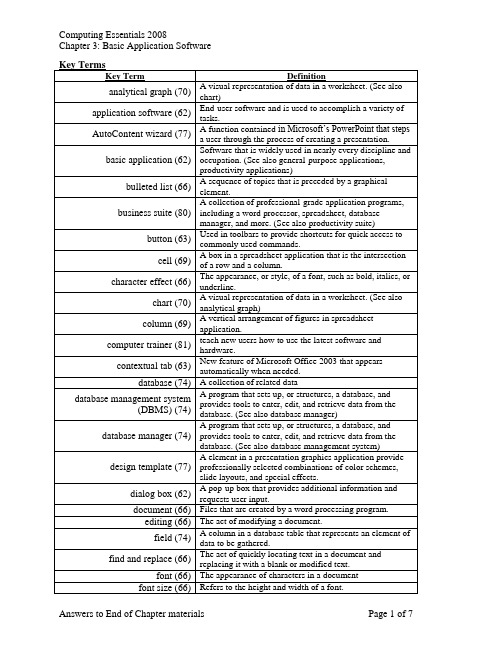
Crossword Puzzle Answers:Open Ended Questions:1.Explain the difference between general-purpose and special-purpose applications.General-purpose applications are widely used in nearly every discipline and occupation. They include word processors, spreadsheets, database management systems, and presentation graphics.special-purpose applications are more narrowly focused on specific disciplines and occupations, such as graphics programs, audio and video editors,2.Discuss the common features of most software programs. Describe the new interfaceintroduced with 2007 Microsoft Office.The newest Office version, 2007 Microsoft Office, has a redesigned interface that is intended to make it easier for users to find and use all the features of an application. This new designintroduces ribbons, contextual tabs, galleries, and more.• Ribbons replace menus and toolbars by organizing commonly used commands into a set of tabs.These tabs display command buttons that are the most relevant to the tasks being performed by the user.• Contextual tabs are tabs that appear automatically. These tabs only appear when they are needed and anticipate the next operations to be performed by the user.• Galleries simplify the process of making a selection from a list of alternatives. This isaccomplished by replacing many dialog boxes with visual presentations of potential results.This new interface is the first major change in over a decade.3.What is the difference between a function and a formula? How is a formula related to what-if analysis?A formula is an instruction to calculate or process. Functions are prewritten formulas providedby the spreadsheet program that perform calculations such as adding a series of cells. If a change is made to one or more numbers in a spreadsheet, all related formulas will automaticallyrecalculate and charts will be recreated. Observing these changes is what-if analysis.4.What are presentation graphics programs? How are they used?Presentation graphics are programs that combine a variety of visual objects to create attractive, visually interesting presentations. They are excellent tools to communicate a message and to persuade people.5.What is the difference between an integrated package and a software suite? Whatare the advantages and disadvantages of each?An integrated package is a single program that provides the functionality of a wordprocessor, spreadsheet, database manager, and more. The primary disadvantage of an integrated package is that the capabilities of each function (such as word processing) are not as extensive as in the individual programs (such as Microsoft Word). The primary advantages are cost and simplicity.A software suite is a collection of separate application programs bundled together andsold as a group. While the applications function exactly the same whether purchased in a suite or separately, it is significantly less expensive to buy a suite of applications than to buy each application separately.1. Expanding Your Technology exercise #3 Shareware explores how shareware programswork and what the risks involved in using them are.2.Writing About Technology exercise #1 Acquiring Software asks the student to explorefive ways of acquiring software. And asks if it is wrong to obtain and use unauthorized software.Web Tools1.Applying Technology exercise #3 Corel WordPerfect Office Suite has the studentresearch the suite and compare/contrast it to the Microsoft Office suite. It asks thestudent to do critical thinking and decide which is better for them.2. Expanding Your Technology exercise #2 Sharing Data between Applications has thestudent research object linking and embedding. The student is asked to provide examples and be able to define the difference between linking and embedding.Software Tools1.Applying Technology exercise #1 Speech Recognition explores the technology of speechrecognition software. How it is configured and what are its uses. It asks them to writeabout the advantages and disadvantages of it.2.Applying Technology exercise #2 Presentation Graphics explores the requirements,features, and uses of a presentation graphics application found on the website.3.Applying Technology exercise #3 Corel WordPerfect Office Suite has the studentscompare and contrast the Corel Suite with the Microsoft Suite products, and asks them to choose one.Writing Skills1.Applying Technology exercise #1 Speech Recognition explores the technology of speechrecognition software. How it is configured and what are its uses. It asks them to writeabout the advantages and disadvantages of it.2.Applying Technology exercise #3 Corel WordPerfect Office Suite has the studentscompare and contrast the Corel Suite with the Microsoft Suite products, and asks them to choose one.3.Expanding Your Knowledge exercise #1 How Speech Recognition Works has the studentexplore how speech recognition could enhance applications and to describe a profession that could benefit from it.4.Expanding Your Technology exercise #3 Shareware explores how shareware programswork and what the risks involved in using them are.5.Writing About Technology exercise #1 Acquiring Software asks the student to explorefive ways of acquiring software. And asks if it is wrong to obtain and use unauthorized software.6.Writing About Technology exercise #2 Software Standards has the student explore theissue of standardization of computer software. It asks them to find out about therequirements of certifications and how compliance is handled.。
计算机科学导论.ppt

16
计算机科学的数学理论体系
数值计算:
主要包括数值分析、数学分析、线性代数、计算几 何、概率论与数理统计
离散数学:
一般认为包含集合论、逻辑学、代数学、图论、组 合学
数论:
包括初等数论、解析数论、代数数论、几何数论
计算理论:
主要包括算法学、计算复杂性理论、程序理论
计算机学科需要支撑其它学科的发展:
科学计算、工程计算等工业软件的开发需要物理学知识
物联网、信息物理系统(CSP)需要物理学知识 量子计算需要物理学知识
总之,现代社会要求通才型、交叉型、综合型人才
22
三大科学思维
推动人类文明进步和科技发展的三大科学:
理论科学,实验科学,计算科学
与三大科学相对应的是三大科学思维:
应试教育强调的正是人工智能擅长的,相比之 下人类学生不具有优势
人工智能不擅长的,人类学生也不擅长
如果不改革教育方式,现在的学生在毕业 之时可能面临着被人工智能淘汰的尴尬处 境
31
正确的学习方式
重视写作与表达的训练:
重视实验报告、课程论文等的写作,多读科技论文,学会条 理清楚、逻辑正确地表述一个工作或自己的观点,能流利地 进行口头表达
28
现行教育方式与人工智能学习特点 高度重合
数学教学:
应试教育:中小学强调计算、题型和公式套用, 缺少逻辑推理训练;高校数学知识碎片化,仍 是简单套公式应付考试,会解题但往往不会活 用数学工具,如根据实际问题建立数学模型
人工智能:擅长计算,已有Matlab等非常强大 的数学和统计软件工具,计算能力远超人类
数学教育看起来只是一种知识教育,但本质上是一种 素质教育
告诉你如何学习好计算机英语?
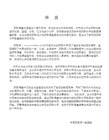
计算机英语的学习不同于考 "托"考"G",无法靠短期的突击来完成。长期的日常学习尤为重要。所谓的日常学习并不需要你抛开工作,安排专门的时间,而是边用边学。比如,你为了解决编程上的一个问题,查阅英文的帮助或技术资料。然而,不少程序员不太喜欢看英文,他们喜欢使用中文版的软件,喜欢汉化的帮助,喜欢读翻译好的书。这实际上就错过了许多日常学习计算机英语的机会。不可否认,读中文肯定比读英文方便,节省时间,但从长期的发展来看,弊大于利。这种对翻译的依赖使许多程序员失去了获取一手资料的宝贵机会。
教材的体系结构--目前计算机英语教材主要分为按语法体系组织和按计算机体系组织的两种结构。如果你是初中级的英语水平建议使用前者,如果你是中高级的英语水平建议使用后者。
教材的易用性--教材的易用性是指教材的编排是否符合人们的学习习惯。虽然计算机英语是专业课程教材,但如果编排活泼、图文并茂、注解查阅方便肯定能调动学习的兴趣,降低阅读的难度。这方面国内的教材应该多向国外的教材学习。
然而国内许多大学的计算机英语课程作为专业英语教学起步较晚,而早期出版的计算机英语教材大多出自于任课老师收集的计算机英文资料,教材规划不够系统,编排也比较简单。这些教材虽然使用的学校较多,为早期的计算机英语教学做出过不可磨灭的贡献,但致命的弱点是内容陈旧、与时代脱节。最典型的代表是清华大学出版社的《计算机英语》,该书最新版本是1997年更新的,里面还充斥着Dos这样的陈旧内容。有些老师苦于没有新颖实用的计算机英语教材,于是一本国外的计算机入门读物《Computing Essentials》(McGraw-Hill出版公司)被许多大学选用为计算机英语教材,效果极佳。这本书现在已经由高等教育出版社影印发行,书名是《计算机专业英语》。该书的特点是:时效性强(版本更新快),新颖实用,编排活泼。但对于中高级英语水平的专业开发人员未免有点太浅。
计算机专业英语影印版(Compu...

Key Terms Page 1of 6 Key TermsKey TermDefinition3G cellular network (249) A computer network that allows users to download data from the Internet at 400 to 700 Kbps using cell phone technology. analog signal (247) Continuous electronic waves. asymmetric digital subscriber line (ADSL) (248) The most widely used types of DSL. backbone (258) A common connecting cable on which all communications travel along. (see also bus) bandwidth (249) A measurement of the width or capacity of the communication channel. base station (254) A network’s centrally located receiver that interprets incoming radio frequencies and routes communications to the appropriate devices. (see also wireless receiver) bits per second (bps) (247) How transfer speed is measured Bluetooth (245) A short-range wireless communication standard that uses microwaves to transmit data over short distances broadband (250) The bandwidth used for high-capacity transmissions. broadcast radio (245) Uses radio signals to send and receive signals from wireless devices. bus (258) A common connecting cable on which all communications travel along. (see also backbone) bus network (258) Each device in the network handles its own communications control. cable modem (249) Use existing television cables to provide high-speed connections to the Internet. cellular service (249) Offer an alternative for mobile devices and laptops. client (251) A node that requests and uses resources available from other nodes. client/server network system (260) A computer network where one computer coordinates and supplies services to other nodes on the network. coaxial cable (244) A high-frequency transmission cable with a single solid-copper core. Communication channel (244) The actual connecting or transmission medium that carries the message. Communication system (243) An electronic system that transmit data from one location to another computer network (251) A communication system that connects two or more computers so that they can exchange information and share resources. connectivity (242) Using computer networks to link people and resources. demodulation (247) The process of converting from analog to digital. dial-up service (248) Using standard telephone lines and conventional modems to link to the Internet or other computers digital signal (247) A representation of the presence or absence of an electronic pulse – on/off digital subscriber line (DSL) (248) Uses existing telephone lines to provide high-speed connections distributed data processing system Computers that can perform processing tasks at their own Key Terms Page 2of 6 (258) dispersed locations. distributed processing (251) A system in which computing power is located and shared at different locations. domain name server (DNS) (250) Converts text-based addresses to IP addresses Ethernet (253) The most common way in which nodes can be connected to one another and communications can be controlled. external modem (247) A modem that stands apart from the computer and typically is connected by a cable to the computer’s serial port. extranet (262) A private network that connects more than one organization. fiber-optic cable (244) Transmits data as pulses of light through tiny tubes of glass. firewall (263) A security system designed to protect an organization’s network against external threats. global positioning system (GPS) (245) Global positioning system (GPS) devices use location information sent by satellites to uniquely determine the geographic location of the device. hierarchical network (258) Consists of several computers linked to a central host computer, but also are hosts to other, smaller computers or peripheral devices. home network (254) Local Area Networks used by individuals in their homes and apartments. host computer (251) A large centralized computer, usually a minicomputer or a mainframe. hub (251) The center or central node for other nodes. infrared (245) A type of wireless connection that uses infrared light waves to communicate over short distances. internal modem (248) A modem that consists of a plug-in circuit board inside the system unit. intranet (262) A private network within an organization that resembles the Internet. IP address (Internet Protocol address) (250) A unique numeric address for every computer on a network. local area network (LAN) (253) Networks with nodes that are in close physical proximity low bandwidth (250) Used for standard telephone communication. (see also voiceband) medium band (250) the bandwidth used in special leased lines to connect minicomputers and mainframes metropolitan area network (MAN) (254) A network that span distances up to 100 miles. microwave (245) A type of communication uses high-frequency radio waves. modem (247) Modulator-demodulator, enables digital microcomputers to communicate across analog telephone lines. modulation (247) The process of converting from digital to analog. network administrator (251, 264) A computer specialist responsible for efficient network operations and implementation of new networks. network gateway (253) A device that allows one LAN to be linked to other LANs or to larger networks. network hub (255) A central unit in a network, such as a server. Key Terms Page 3of 6 network interface card (NIC) (251) Expansion cards located within the system unit that connect the computer to a network network operating system (NOS) (251) An operating system that control and coordinate the activities of all computers and other devices on a network. node (251) Any device that is connected to a network. packet (250) Data reformatted or broken down into small parts PC Card modem (248) A modem that is a credit card –size expansion board that is inserted into portable computers peer-to-peer network system (261) A network system where nodes have equal authority and can act as both clients and servers. polling (255) A type of communications where each connecting device is asked whether it has a message to send. protocol (250) Rules for exchanging data between computers proxy server (263) A computer through which all communications between the company’s internal n etworks and the outside world must pass. ring network (258) Each device is connected to two other devices, forming a ring with no central computer satellite (245) A type of communication that uses satellites orbiting about 22,000 miles above the earth as microwave relay stations. satellite/air connection service (249) Use satellites and the air to download or send data to users at a rate seven times faster than dial-up connections. server (251) A node that shares resources with other nodes. star network (255) A number of small computers or peripheral devices are linked to a central unit. strategy (260) A way of coordinating the sharing of information and resources T1, T2, T3, T4 lines (248) Special high-speed lines leased from telephone companies. telephone line (244) A type of cable that uses 2, 4, or 8 pairs of copper wire. terminal network (260) A network system where processing power is centralized in one large computer, usually a mainframe. time-sharing system (258) Several users can share resources (time) on a central computer. topology (255) How a network is arranged or configured transfer rate (247) The speed at which data can be transmitted Transmission Control Protocol/Internet Protocol (TCP/IP) (250) The standard protocol for the Internet voiceband (250) Used for standard telephone communication. (see also low bandwidth) wide area network (WAN) (254) A countrywide or worldwide network that spans distances greater than 100 miles. Wi-FI (wireless fidelity) (245) A wireless standard used to connect computers to each other and to the Internet. wireless LAN (WLAN) (254) Local area network that uses wireless devices to connect nodes together. wireless modem (248) A modem that may be internal, external, or a PC Card sends and receives through the air. wireless receiver (254) A network’s centrally located receiver that interprets incoming radio frequencies and routes communications to the appropriate devices. (see also base station) Crossword Puzzle Answers:AcrossNum. Clue Answer 5 Interprets and routs incoming radio frequencies. Base station7 Continuous electronic waves. Analog9 Configuration of a network. topology10 Network interface card. NIC11 Transfer speed or transfer rate. bps12 Short range wireless communication standard. bluetooth14 Measurement of the width of the communication channel. bandwidth DownNum. Clue Answer 1 Node that requests and uses resources available from other nodes. client 2 Each device in the network handles its own communications. Bus network 3 Device that allows links between LANs. Network gateway 4 Process that converts digital to analog. modulation6 Pieces of a message sent over the Internet. packets8 Global positioning system. GPS13 Any device that is connected to a network. node15 Uses existing telephone lines to provide high-speed connections. DSL 16 Central node for other nodes. hubNum Multiple ChoiceAnswers Matching Answers1 C G 2 B B 3 A A 4 D I 5 C H 6 D E 7 B C 8 B J 9 B D 10 D F Open Ended Questions:to another 2.Identify and describe the various physical and wireless communication channels.PhysicalTelephone lines - consist of twisted-pair cable made up of hundreds of copper wires. Coaxial cable- a high-frequency transmission cable with a single solid-copper core. Fiber-optic cable - transmits data as pulses of light through tiny tubes of glass. WirelessInfrared - uses infrared light waves to communicate over short distances. Broadcast radio sends and receive radio signals through transceivers. Microwave - uses high-frequency radio waves. Satellite - uses satellites orbiting above the earth as microwave relay stations. 3.Identify the standard Internet protocol and discuss its essential features.The standard protocol for the Internet is TCP/IP (transmission control protocol/Internet protocol). Every computer on the Internet has a unique numeric address called an IP address. Information is reformatted or broken down into small parts called packets. 4.Define and discuss the four principal network topologies.S tar network - a number of small computers or peripheral devices are linked to a central unit. Bus network - each device in the network handles its own communications control. Ring network - each device is connected to two other devices, forming a ring. Hierarchical network— consists of several computers linked to a central host computer, and also hosts to other, smaller computers or to peripheral devices. 5.Define and discuss the three most common network strategies.Terminal network system,- processing power is centralized in one large computer, usually a mainframe. - use one computer to coordinate and supply services to other Client/server network systems - use one computer to coordinate and supply services to other nodes on the network. Peer-to-peer network system, nodes have equal authority and can act as both clients and servers. Answers to End of Chapter materials Page 5 of 6 Focus Applying Technology Expanding YourKnowledgeWriting AboutTechnologyEthical Electronic Monitoring Digital Rights Management Web Tools Palm How Napster and Gnutella Work Software Tools Home Networking Distributed Computing How Wireless Home Networks Work Hotspots Writing Skills Ethical focusWriting About Technology exercise #1 Electronic Monitoring explores the FBI Carnivore monitoring system and how it affects personal privacy. Writing About Technology exercise #2 Digital Rights Management explores the issue of sharing copyrighted material over the Internet and how it affects software piracy. Applying Technology exercise #3 Palm explores how Palms work with the Internet and looks at the types of information are available. Expanding Your Knowledge #2 How Napster and Gnutella Work looks at the different types of network architectures employed by each program and their efficiencies. Applying Technology exercise #1 Home Networking works with the Making it Work for you section in exploring the different types of home networking and how to configure Applying Technology exercise #2 Distributed Computing has the students research the concept of distributed computing, how it works, and why it is beneficial. Expanding Your Knowledge exercise #1 How Wireless Home Networks Work has the students discover basic features and functionalities of home networking and how they can Expanding Your Knowledge exercise #3 Hotspots has the student explore the technology of public Internet access and what is necessary to use it. 。
计算机专业英语:二级存储器
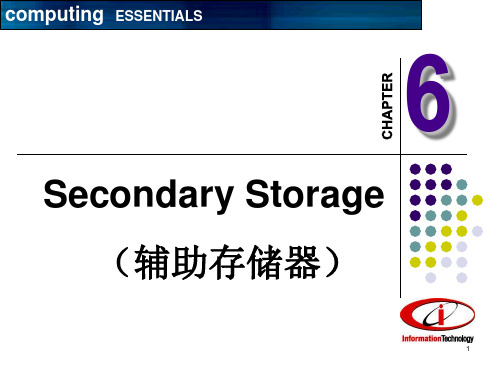
24
12
computing
ESSENTIALS
Optical Disks(光盘) (光盘)
Very large capacity Up to 17 gigabytes Use reflected light projected by a laser Lands and Pits represent 1’s and 0’s Formats Compact Disk (CD) Digital Versatile Disk (DVD) DataPlay
Metallic disks Fast retrieval, greater capacity Read/write heads ride cushion of air .000001” thick Three types Internal hard disk Hard-disk cartridge Hard-disk pack
20
computing
ESSENTIALS
ห้องสมุดไป่ตู้
Magnetic Tape(磁带) (磁带)
Sequential access Commonly used for backing-up data Very large capacity Types of magnetic tape Tape cartridges Magnetic tape reels
High Capacity Floppy Disks
(高容量软盘) 高容量软盘)
Floppy disk cartridges Zip Disks 250 MB SuperDisks 120 MB HiFD disks 200 MB
6
computing
ESSENTIALS
计算机导论课程介绍

二○○四年十月
《计算机导论》课程性质
《计算机科学导论》或《计算机导论与算法》 等名称,但绝对不等于《计算机应用基础》等 非计算机专业的课程!
计算机专业的一门重要的专业基础课程,本课程将全 面介绍计算机科学技术学科体系结构、学科形态、核 心概念以及研究方法等,阐述计算机科学各专业的知 识结构和培养方向,引导学生进入计算机科学学习的 大门。 内容广泛而浅显 本课程为计算机科学与技术专业的专业必修课
理论+实践
软件工程(电子政务) 3
参考书目
董荣胜,古天龙 . 计算机科学与技术方法论,人民邮电出 版社 钟珞. 计算机科学导论, 武汉理工大学出版社,2003 祁亨年. 计算机导论. 清华大学出版社,2003 J.Glenn Brookshear .Computer Science:An Overview(第7 版 影印版)。北京:清华大学出版社,2004
作业 考勤 课堂表现
软件工程(电子政务)
5
网络资源
搜索引擎
om
知名大学的计算机系网站
软件工程(电子政务) 6
计算机科学概论. 人民邮电出版社,2003
Timothy J.O‘Leary, Linda I.O’Leary . Computing Essentials(影印版):高等教育出版社, 2000 闵应骅. 作为学科的计算科学. 清华大学出版社,1994
软件工程(电子政务)
4
课程成绩计算
期末考试:60% 平时:40%
软件工程(电子ห้องสมุดไป่ตู้务) 2
本课程的教学目的
了解计算机科学的知识结构 掌握: 掌握
1. 了解计算机基础知识; 2. 使学生初步了解计算机的硬件组成及其功能; 3. 使学生初步了解计算机软件的相关技术。 4. 使学生初步了解计算机网络的基础知识; 5. 使学生初步了解多媒体计算机的知识。
Dell OpenManage Essentials 2.0.1 用户指南.pdf_17008353
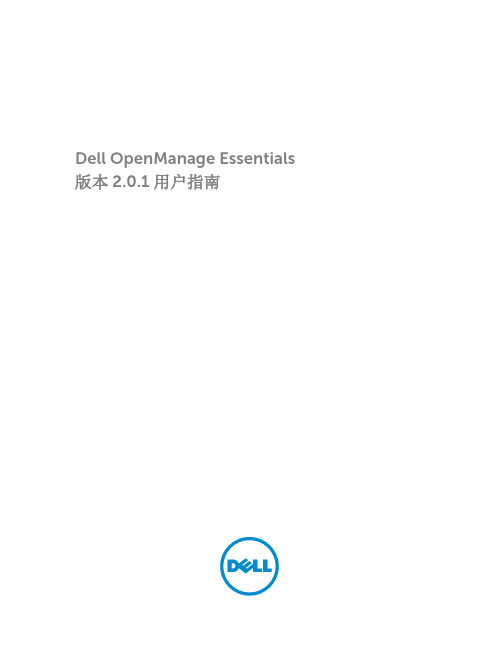
Dell OpenManage Essentials 版本 2.0.1 用户指南注、小心和警告注: “注”表示可以帮助您更好地使用计算机的重要信息。
小心: “小心”表示可能会损坏硬件或导致数据丢失,并说明如何避免此类问题。
警告: “警告”表示可能会造成财产损失、人身伤害甚至死亡。
版权所有© 2014 Dell Inc. 保留所有权利。
本产品受美国、国际版权和知识产权法律保护。
Dell™和 Dell 徽标是 Dell Inc. 在美国和 / 或其他管辖区域的商标。
所有此处提及的其他商标和产品名称可能是其各自所属公司的商标。
2014 - 12Rev. A00目录1 关于 OpenManage Essentials (17)本发行版中的新增功能 (17)您可能需要的其他信息 (17)联系 Dell (18)2 安装 OpenManage Essentials (19)安装的前提条件和最低要求 (19)最低建议硬件 (19)最低要求 (20)使用关系数据库管理系统的条款及细则 (20)Microsoft SQL Server 的最低权限登录角色 (21)数据库大小和可扩展性 (21)下载 OpenManage Essentials (22)安装 OpenManage Essentials (22)自定义设置安装 (23)在域控制器上安装 OpenManage Essentials 时的考虑事项 (24)在远程 SQL Server 上设置 OpenManage Essentials 数据库 (24)安装 Dell SupportAssist (25)安装 Repository Manager (26)安装 Dell License Manager (26)卸载 OpenManage Essentials (27)升级 OpenManage Essentials (27)设置和配置 VMware ESXi 5 (28)迁移 IT Assistant 至 OpenManage Essentials (29)3 OpenManage Essentials 使用入门 (30)启动 OpenManage Essentials (30)配置 OpenManage Essentials (30)查找向导配置 (31)配置查找设置 (31)使用 OpenManage Essentials 门户主页 (31)OpenManage Essentials 标题横幅 (32)自定义门户 (33)显示其它可用的报表和图形 (34)提取图表和报告以获得更多信息 (34)保存与载入门户布局 (35)更新门户数据 (35)隐藏图形和报告(组件) (35)重新排列图形和报告(组件)或调整其大小 (35)筛选数据 (36)搜索栏 (36)搜索项目 (37)搜索下拉列表 (37)选择操作 (37)地图视图(主页)门户 (38)查看用户信息 (38)以不同用户身份登录 (38)使用“有可用更新”通知图标 (39)使用保修警示牌通知图标 (39)4 OpenManage Essentials 主页门户—参考 (40)仪表板 (40)门户主页报告 (40)按状态分类的设备 (41)按严重性分类的警报 (41)已查找到的设备与已进行资源清册的设备 (41)任务状态 (42)计划视图 (42)计划视图设置 (42)设备保修报告 (43)地图视图(主页)门户界面 (44)5 设备查找和资源清册 (45)支持的设备、协议和功能值表 (45)支持的操作系统(服务器)、协议和功能值表 (49)支持的存储设备、协议和功能值表 (51)图例和定义 (52)使用查找和资源清册门户 (53)用于查找的协议支持值表 (53)用于系统更新的协议支持值表 (55)设备未报告服务标签 (55)配置查找和资源清册任务 (56)更改默认的 SNMP 端口 (57)使用 WS-Man 协议和根证书查找和资源清册 Dell 设备 (57)排除范围 (58)查看已配置的查找和资源清册范围 (59)计划查找 (59)查找速度滑块 (59)多线程 (59)计划资源清册 (60)配置状态轮询频率 (60)6 查找和资源清册 - 参考 (61)查找和资源清册门户页面选项 (61)查找和资源清册门户 (61)上一次查找和资源清册 (62)已查找到的设备与已进行资源清册的设备 (62)任务状态 (63)查看设备摘要 (63)查看设备摘要筛选选项 (63)Object Missing (64)查找配置 (64)查找配置选项 (64)设备类型筛选 (65)ICMP 配置 (65)ICMP 配置选项 (66)SNMP 配置 (66)SNMP 配置选项 (66)WMI 配置 (67)WMI 配置选项 (67)存储配置 (67)存储配置选项 (67)WS-Man 配置 (68)WS-Man 配置选项 (68)SSH 配置 (68)SSH 配置选项 (69)IPMI 配置 (69)IPMI 配置选项 (69)查找范围操作 (70)摘要 (70)添加排除范围 (70)添加排除范围选项 (70)查找计划 (71)查看查找配置 (71)查找计划设置 (71)资源清册计划 (72)资源清册计划设置 (72)状态计划 (73)状态轮询计划设置 (73)查找范围 (74)排除范围 (74)7 管理设备 (75)查看设备 (75)设备摘要页面 (75)节点和符号说明 (77)设备详情 (77)查看设备的资源清册 (78)查看警报摘要 (78)查看系统事件日志 (79)搜索设备 (79)创建新组 (79)将设备添加到新组 (80)将设备添加到现有组 (80)隐藏组 (80)删除组 (80)单一登录 (81)创建自定义 URL (81)启动自定义 URL (81)配置保修电子邮件通知 (82)配置保修警示牌通知 (82)配置保修弹出通知 (83)使用地图视图 (83)地图提供程序 (85)配置地图设置 (85)一般导航和缩放 (86)主视图 (86)工具提示 (87)在地图视图上选择设备 (87)运行和连接状态 (87)在相同位置的多个设备 (88)设置主视图 (88)查看所有地图位置 (88)将设备添加到地图 (89)使用“编辑位置详细信息”选项移动设备位置 (89)导入已授权设备 (90)使用地图视图搜索栏 (91)移除所有地图位置 (92)编辑地图位置 (93)移除地图位置 (93)导出所有设备位置 (93)Dell PowerEdge FX 机箱视图 (94)工具提示和设备选择 (94)覆盖 (95)右键单击操作 (95)导航痕迹 (96)支持 PowerEdge FX 机箱底座 (96)Dell NAS 设备支持 (96)OEM 设备支持 (97)8 设备—参考 (98)查看资源清册 (98)查看警报 (99)查看硬件日志 (99)硬件日志详细情况 (99)警报筛选器 (99)查看非符合系统 (100)非符合系统 (100)设备搜索 (101)查询结果 (102)创建设备组 (102)设备组配置 (102)设备选择 (102)摘要—组配置 (103)地图视图(设备)选项卡界面 (104)在此位置的设备 (105)地图设置 (105)9 服务器部署和重新配置 (106)OpenManage Essentials - 服务器配置管理许可证 (107)可获许可的服务器 (107)购买许可证 (107)部署许可证 (107)验证许可证信息 (107)查看未获得许可的服务器目标 (107)部署和符合性任务的设备要求 (108)设备配置部署使用入门 (108)设备配置部署概览 (109)查看部署门户 (109)配置部署文件共享 (109)创建设备配置模板 (109)从设备配置文件创建设备配置模板 (110)从参考设备创建设备配置模板 (111)添加设备到重新利用和裸机设备组 (111)管理设备配置模板 (112)查看设备配置模板属性 (112)克隆设备配置模板 (112)编辑设备配置模板 (113)导出设备配置模板 (113)部署设备配置模板 (114)部署网络 ISO 映像 (115)从“调整用途和裸机设备”组中移除设备 (116)自动部署设备配置 (117)配置自动部署设置 (117)设置设备配置自动部署 (117)管理自动部署凭据 (119)为自动部署添加查找范围 (120)从自动部署任务移除设备 (120)导入特定于设备的属性 (121)导入文件的要求 (121)导出特定于设备的属性 (122)查看部署任务 (122)附加信息 (122)10 部署 - 参考 (123)重新利用和裸机设备 (124)自动部署 (125)任务 (125)任务执行历史 (126)设备配置模板详细信息 (127)设备配置设置向导 (127)文件共享设置 (128)添加设备到重新利用和裸机设备组 (128)创建模板向导 (128)部署模板向导 (129)名称和部署选项 (129)选择模板 (129)选择设备 (130)选择 ISO 位置 (130)编辑属性 (130)设置计划 (132)摘要 (133)设置自动部署向导 (133)部署选项 (134)选择模板 (134)选择 ISO 位置 (134)导入服务标签/节点 ID (135)编辑属性 (135)执行凭据 (137)摘要 (138)管理自动部署凭据 (139)凭据 (139)设备 (139)11 管理服务器配置基线 (141)查看设备符合性门户 (141)设备配置符合性使用入门 (142)设备配置符合性概览 (142)配置凭据和设备配置资源清册计划 (142)关联目标设备至配置模板 (143)查看资源清册配置详细信息 (144)查看设备符合性状态 (144)查看合规性任务 (144)12 配置 - 参考 (145)设备符合性 (146)设备符合性图形 (146)设备符合性表格 (146)任务 (147)任务执行历史 (147)关联设备到模板向导 (148)选择模板 (148)选择设备 (148)配置资源清册计划向导 (149)资源清册凭据 (149)计划 (149)13 查看资源清册报告 (151)选择预定义报告 (151)预定义报告 (151)筛选报告数据 (153)导出报告 (153)14 报告—参考 (154)代理和警报摘要 (155)代理摘要iDRAC Service Module 摘要 (155)设备警告 (156)生成警报最多的系统 (156)设备合规性 (156)服务器概览 (156)服务器组件和版本 (157)资产收购信息 (157)资产维护信息 (158)资产支持信息 (158)硬盘驱动器信息 (159)ESX 信息 (160)HyperV 信息 (160)现场可替换单元 (FRU) 信息 (161)许可证信息 (161)设备位置信息 (161)内存信息 (162)模块化机柜信息 (162)NIC 信息 (162)PCI 设备信息 (163)存储控制器信息 (163)虚拟磁盘信息 (163)保修信息 (164)BIOS 配置 (165)iDRAC 网络配置 (165)模板关联 (166)15 查看保修报告 (167)延长保修 (167)16 管理警报 (168)查看警报和警报类别 (168)查看警报日志 (168)了解警报类型 (168)查看内部警报 (169)查看警报类别 (169)查看警报源详细信息 (169)查看先前配置的警报操作 (169)查看应用程序启动警报操作 (170)查看电子邮件警报措施 (170)查看警报忽略措施 (170)查看警报陷阱转发措施 (170)处理警报 (170)标记警报 (170)创建和编辑新视图 (170)配置警报措施 (171)设置电子邮件通知 (171)忽略警报 (172)运行自定义脚本 (172)转发警报 (173)转发警报用例案例 (173)参考样本警报措施使用案例 (174)警报措施中的用例 (174)配置警报日志设置 (174)重命名警报类别和警报源 (175)警报弹出通知 (175)配置警报弹出通知 (175)启用或禁用警报弹出通知 (176)17 警报—参考 (177)警报日志 (177)预定义的警报视图筛选器 (178)警报日志字段 (178)警报详细信息 (179)警报日志设置 (179)警报视图筛选器 (180)警报筛选器名称 (180)严重性 (180)确认 (181)摘要——警报视图筛选器 (181)警报操作 (182)名称和说明 (182)严重性关联 (182)应用程序启动配置 (183)电子邮件配置 (184)陷阱转发 (185)类别和源关联 (185)设备关联 (185)日期和时间范围 (187)警报措施 - 重复警报关联 (187)摘要 - 警报操作详细信息 (187)警报类别 (188)警报类别选项 (189)警报源 (190)18 更新服务器 BIOS、固件、驱动程序和应用程序 (192)查看系统更新页面 (192)了解服务器 BIOS 固件和驱动程序源 (193)为更新选择正确源 (193)选择更新目录源 (193)查看比较结果 (194)查看符合服务器 (194)查看非符合服务器 (194)查看未盘点的服务器 (194)查看有问题的服务器和解决方案 (194)系统更新用例案例 (194)应用系统更新 (196)查看更新状态 (198)更新固件、BIOS 和驱动程序而不使用 OMSA (198)查看当前目录 (198)问题和解决方案用例案例 (199)19 系统更新—参考 (200)筛选选项 (200)系统更新 (201)符合性报告 (201)符合系统 (202)非符合系统 (203)系统更新任务 (204)未资源清册的系统 (205)资源清册系统 (205)所有系统更新任务 (205)问题和解决方案 (206)任务执行历史 (206)选择目录源 (207)Dell Update Package(Dell 更新软件包) (207)Dell OpenManage Server Update Utility (207)Repository Manager (208)查看当前目录 (208)20 管理远程任务 (209)关于远程任务 (209)管理命令行任务 (209)管理 RACADM 命令行任务 (210)管理通用命令行任务 (211)管理服务器电源选项 (212)部署 Server Administrator (212)支持的 Windows 和 Linux 软件包 (214)参数 (214)部署 iDRAC Service Module (215)支持的 Windows 和 Linux 软件包 (216)收集固件和驱动程序资源清册 (216)使用样本远程任务用例 (217)远程任务用例 (218)设备功能值表 (219)21 远程任务—参考 (222)远程任务主页 (223)远程任务 (223)所有任务 (223)任务执行历史 (224)服务器电源选项 (225)部署任务 (227)命令行任务 (229)远程 Server Administrator 命令 (229)通用命令 (231)IPMI 命令 (232)RACADM 命令行 (234)固件和驱动程序资源清册收集任务 (235)22 管理安全设置 (237)使用安全角色和权限 (237)Microsoft Windows 验证 (237)分配用户权限 (238)使用自定义 SSL 证书(可选) (238)配置 IIS 服务 (238)在 OpenManage Essentials 中支持的协议和端口 (238)在管理站上支持的协议和端口 (238)在受管节点上支持的协议和端口 (239)23 故障排除 (240)OpenManage Essentials 故障排除工具 (240)排除故障的程序 (240)资源清册的故障排除 (240)设备查找的故障排除 (241)排除接收 SNMP 陷阱故障 (242)基于 Windows Server 2008 服务器查找的故障排除 (242)针对 ESX 或 ESXi 版本 3.5、4.x 或 5.0 的 SNMP 陷阱进行故障排除 (242)使用 Microsoft Internet Explorer 进行故障排除 (242)地图视图故障排除 (243)24 常见问题 (245)安装 (245)升级 (245)任务 (246)可选命令行设置 (246)自定义参数 (248)MSI 返回代码 (249)电子邮件警报措施 (249)查找 (249)资源清册 (251)系统更新 (251)管理设备配置 (252)设备组权限 (252)设备组权限门户 (252)远程和系统更新任务 (253)自定义设备组 (254)日志 (254)日志级别 (254)故障排除 (255)25 管理设备组权限 (256)向 OmeSiteAdministrators 角色添加用户 (256)向用户分配设备组 (257)从 OmeSiteAdministrators 角色移除用户 (257)26 OpenManage Mobile 设置 (259)启用或禁用 OpenManage Mobile 的警报通知 (259)启用或禁用 OpenManage Mobile 订户 (260)删除 OpenManage Mobile 订户 (260)查看警报通知服务状态 (260)通知服务状态 (261)查看 OpenManage Mobile 订户信息 (261)移动订户信息 (261)OpenManage Mobile 故障排除 (262)27 首选项—参考 (264)控制台设置 (264)电子邮件设置 (265)警报设置 (266)自定义 URL 设置 (266)保修通知设置 (266)设备组权限 (268)常见任务 (268)管理设备组权限 (268)用于执行任务和打补丁的设备组 (268)查找设置 (268)部署设置 (268)28 日志—参考 (270)用户界面日志 (270)应用程序日志 (271)29 扩展 (272)30 右键单击操作 (273)计划视图 (273)设备状态 (274)查找范围摘要 (274)管理包含范围 (274)查看筛选器 (275)警报 (275)远程任务 (275)自定义 URL (276)系统更新任务 (276)“属性”选项卡 (276)模板 (277)符合模板 (277)设备合规性 (277)31 教程 (278)32 使用 OpenManage Essentials 命令行界面 (279)启动 OpenManage Essentials 命令行界面 (279)创建查找配置文件输入文件 (279)使用 XML 或 CSV 文件指定 IP、范围或主机名 (280)在 PowerShell 中指定输入文件 (280)命令行界面命令 (281)创建查找范围 (281)删除查找范围 (281)创建查找范围组 (282)删除查找范围组 (282)编辑查找范围 (282)编辑查找范围组 (283)启用查找范围或查找范围组 (283)禁用查找范围或查找范围组 (283)创建查找排除范围 (284)删除查找排除范围 (284)运行查找、资源清册和状态轮询任务 (284)移除设备 (285)检索查找范围的状态执行进度 (285)停止正在运行的查找范围或组 (286)创建自定义设备组 (286)将设备添加到自定义组 (286)删除组 (287)1关于 OpenManage EssentialsOpenManage Essentials 是一个硬件管理应用程序,可对企业网络中的 Dell 系统、设备和组件提供全面概览。
国外大学部分现用教材及教学参考书
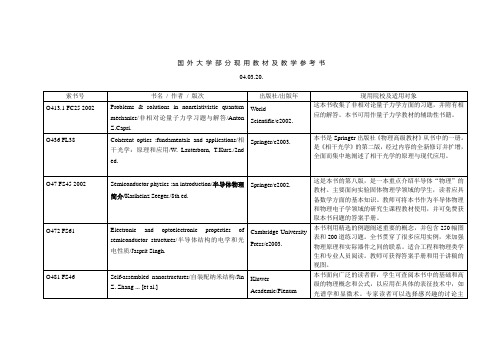
本书是一本有关人工智能的经典教材,已被宾夕法尼亚州立大学、南加州大学、马里兰大学、杜克大学、布朗大学等多所著名大学采用。
TP183 FX8
Linear and nonlinear iterative learning control/线性和非线性递推学习控制/Jian-Xin Xu, Ying Tan.
Kluwer Academic/Plenum Publishers/c2003.
本书面向广泛的读者群:学生可查阅本书中的基础和高级的物理概念和公式,以应用在具体的表征技术中,如光谱学和显微术。专家读者可以选择感兴趣的讨论主题,阅读有关总结和更新内容。教师可把部分内容用在本科生和研究生的课程中,如基于纳米结构单元的自装配的体系。工业界的科研人员或者工程师可关注纳米结构的应用内容,如物理、化学、生物系统等。
国外大学部分现用教材及教学参考书
04.03.20.
索书号
书名/作者/版次
出版社/出版年
现用院校及适用对象
O413.1 FC25 2002
Problems & solutions in nonrelativistic quantum mechanics/非相对论量子力学习题与解答/Anton Z.Capri.
TP3 FO45 2002
Computing essentials 2002-2003/计算机专业英语/Timothy J.O'Leary, Linda I. O'Leary.
高等教育出版社;McGraw-Hill Education/c2003.
本书是一本计算机导论性英语教材,该书自1989年以来,每年出版一本新版。高等教育出版社引入此书,适合我国各个高等学校作为计算机英语教材使用。
高职院校计算机专业英语课程教学分析与改革
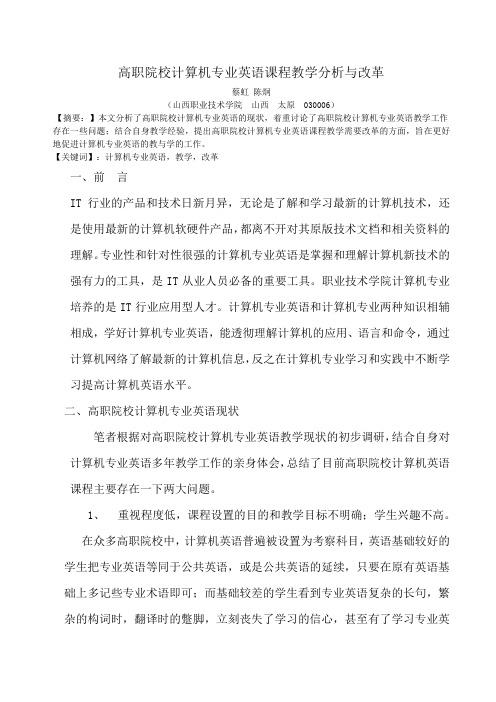
高职院校计算机专业英语课程教学分析与改革蔡虹陈炯(山西职业技术学院山西太原 030006)【摘要:】本文分析了高职院校计算机专业英语的现状,着重讨论了高职院校计算机专业英语教学工作存在一些问题;结合自身教学经验,提出高职院校计算机专业英语课程教学需要改革的方面,旨在更好地促进计算机专业英语的教与学的工作。
【关键词】:计算机专业英语,教学,改革一、前言IT 行业的产品和技术日新月异,无论是了解和学习最新的计算机技术,还是使用最新的计算机软硬件产品,都离不开对其原版技术文档和相关资料的理解。
专业性和针对性很强的计算机专业英语是掌握和理解计算机新技术的强有力的工具,是IT从业人员必备的重要工具。
职业技术学院计算机专业培养的是IT行业应用型人才。
计算机专业英语和计算机专业两种知识相辅相成,学好计算机专业英语,能透彻理解计算机的应用、语言和命令,通过计算机网络了解最新的计算机信息,反之在计算机专业学习和实践中不断学习提高计算机英语水平。
二、高职院校计算机专业英语现状笔者根据对高职院校计算机专业英语教学现状的初步调研,结合自身对计算机专业英语多年教学工作的亲身体会,总结了目前高职院校计算机英语课程主要存在一下两大问题。
1、重视程度低,课程设置的目的和教学目标不明确;学生兴趣不高。
在众多高职院校中,计算机英语普遍被设置为考察科目,英语基础较好的学生把专业英语等同于公共英语,或是公共英语的延续,只要在原有英语基础上多记些专业术语即可;而基础较差的学生看到专业英语复杂的长句,繁杂的构词时,翻译时的蹩脚,立刻丧失了学习的信心,甚至有了学习专业英语的心里障碍;加之考察课的缘故,没有明确的教学目的和教学目标,这些使得教师的教和学生的学都缺乏了动力,导致了不重视的结果。
2、教材内容陈旧,与企业需求脱节;体系结构不科学,教学手段落后。
目前大多高职院校使用的教材是1997年清华大学出版社出版的《计算机英语》,无庸置疑,该教材为早期的计算机英语教学做出了不可磨灭的贡献。
学习专业英语的心得

学习专业英语的心得(经典版)编制人:__________________审核人:__________________审批人:__________________编制单位:__________________编制时间:____年____月____日序言下载提示:该文档是本店铺精心编制而成的,希望大家下载后,能够帮助大家解决实际问题。
文档下载后可定制修改,请根据实际需要进行调整和使用,谢谢!并且,本店铺为大家提供各种类型的经典范文,如工作计划、工作总结、合同协议、条据书信、规章制度、应急预案、策划方案、教学资料、作文大全、其他范文等等,想了解不同范文格式和写法,敬请关注!Download tips: This document is carefully compiled by this editor. I hope that after you download it, it can help you solve practical problems. The document can be customized and modified after downloading, please adjust and use it according to actual needs, thank you!Moreover, our store provides various types of classic sample essays, such as work plans, work summaries, contract agreements, document letters, rules and regulations, emergency plans, planning plans, teaching materials, complete essays, and other sample essays. If you want to learn about different sample formats and writing methods, please pay attention!学习专业英语的心得【热】学习专业英语的心得(集锦12篇)下面是本店铺分享的【热】学习专业英语的心得(集锦12篇)供大家阅读。
学习专业英语的心得总结范例
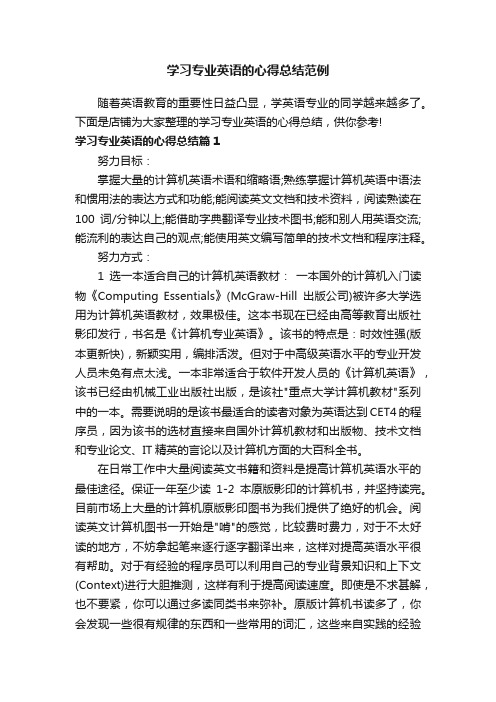
学习专业英语的心得总结范例随着英语教育的重要性日益凸显,学英语专业的同学越来越多了。
下面是店铺为大家整理的学习专业英语的心得总结,供你参考!学习专业英语的心得总结篇1努力目标:掌握大量的计算机英语术语和缩略语;熟练掌握计算机英语中语法和惯用法的表达方式和功能;能阅读英文文档和技术资料,阅读熟读在100词/分钟以上;能借助字典翻译专业技术图书;能和别人用英语交流;能流利的表达自己的观点;能使用英文编写简单的技术文档和程序注释。
努力方式:1选一本适合自己的计算机英语教材:一本国外的计算机入门读物《Computing Essentials》(McGraw-Hill出版公司)被许多大学选用为计算机英语教材,效果极佳。
这本书现在已经由高等教育出版社影印发行,书名是《计算机专业英语》。
该书的特点是:时效性强(版本更新快),新颖实用,编排活泼。
但对于中高级英语水平的专业开发人员未免有点太浅。
一本非常适合于软件开发人员的《计算机英语》,该书已经由机械工业出版社出版,是该社"重点大学计算机教材"系列中的一本。
需要说明的是该书最适合的读者对象为英语达到CET4的程序员,因为该书的选材直接来自国外计算机教材和出版物、技术文档和专业论文、IT精英的言论以及计算机方面的大百科全书。
在日常工作中大量阅读英文书籍和资料是提高计算机英语水平的最佳途径。
保证一年至少读1-2本原版影印的计算机书,并坚持读完。
目前市场上大量的计算机原版影印图书为我们提供了绝好的机会。
阅读英文计算机图书一开始是"啃"的感觉,比较费时费力,对于不太好读的地方,不妨拿起笔来逐行逐字翻译出来,这样对提高英语水平很有帮助。
对于有经验的程序员可以利用自己的专业背景知识和上下文(Context)进行大胆推测,这样有利于提高阅读速度。
即使是不求甚解,也不要紧,你可以通过多读同类书来弥补。
原版计算机书读多了,你会发现一些很有规律的东西和一些常用的词汇,这些来自实践的经验非常宝贵,并让你终生受益。
- 1、下载文档前请自行甄别文档内容的完整性,平台不提供额外的编辑、内容补充、找答案等附加服务。
- 2、"仅部分预览"的文档,不可在线预览部分如存在完整性等问题,可反馈申请退款(可完整预览的文档不适用该条件!)。
- 3、如文档侵犯您的权益,请联系客服反馈,我们会尽快为您处理(人工客服工作时间:9:00-18:30)。
• •
Spam(垃圾邮件) (垃圾邮件)
Unwanted and unsolicited e-mails /unwelcomed mail
Spam blockers
Blocker in mail server(服务器) (服务器) Blocker in mail client(客户端) (客户端)
7/15
Computing Essentials - Copyright © 2008 Mo. Yijun All rights reserved
2/15
What are people doing in Internet? (1)
Communicating
•
Draw people more closer. You can contact with family and friends anywhere. (E-mail、IM and Discussion) 、 Window shop instead of go to shopping-mall. Look for the latest fashion, search for bargains, and make purchases. Accessing useful news, articles, and knowledge from massive information. Avoiding loss in Internet. Enjoying yourself. Including music, movies, magazines, and computer games. Taking classes and exams on almost any subject.
6/15
Web pages
•
Hyperlinks/links
•
Applets
•
Computing Essentials - Copyright © 2008 Mo. Yijun All rights reserved
Communication (1)
• • •
Mail is the transmission of electronic messages over the Internet. Graphics、Photos、and other attachments can be 、 、 included in e-mail. Email header
Computing Essentials - Copyright © 2008 Mo. Yijun All rights reserved
Communication(2)
Instant Messenger ()
•
•
•
•
Talking with one’s friends via short message, voice or video Checking status of one’s friends and being notified when a friend is online. Sharing file with friends and assisting users with remote operation. MSN Messenger, Yahoo Messenger, ICQ、QQ、Fetion 、 、 、WangWang、TS (Team Speaker) 、
•
Wireless Service Providers
Providing Internet connections for computer with wireless modems or access points. 3G、4G and WLAN 、
•
Internet Content Providers
Spiders Looking for new information and update the search service’s databases. Indexed Database To speed search Search engines Kerectory Search:hao123,yahoo : , MetaSearch engines: Programs that automatically submit your search request to several search engines simultaneously. Dogpile Specialized search engines: focus on subject-specific websites. scholar.google, library in HUST.
Name of the service
URL
• •
Rule for exchanging data between computers http:// ftp:// rstp://
•
HTML
• •
Hyper Markup Language Documents contain text、tag、link, and music、video、resources 、 、 、 、 Interpreted pages of HTML documents and commands . A symbol links to connect to other documents containing related information. Special programs in web pages, which are typically written in Java, and run with other page.
•
Common interest
Brining together individuals that share common interests or hobbies Flickr (Share images) Linkedln (Business contact), Meetup(special interest group), Sohu Group, 一大把群组
Computing Essentials - Copyright © 2008 Mo. Yijun All rights reserved
8/15
Communication(3)
Social Networking
•
Reuniting
Connecting people who have known one another but have lost touch. Classmates Online,Facebook, QQ,Fetion , , ,
9/15
Computing Essentials - Copyright © 2008 Mo. Yijun All rights reserved
Search Tools
Search Services • Operating web sites that help you locate the information you need. • Three Main elements
ACCESS
Providers
•
Internet service providers
Providing user path or connection to access the internet.
•
National Service Providers
Providing access through standard telephone or cable. CERNET、China Mobile、China Union、China 、 、 、 Telecommunication、Great-wall Broadband Network 、
Chapter 2 The Internet, The WEB and Electronic Commerce
Computing Essentials - Copyright © 2008 Mo. Yijun All rights reserved
1/15
Competencies 能力
Origin of the Internet and Web Web access Internet Communication Search Tools Electronic commerce(电子商务) (电子商务) Web Utilities(工具) (工具)
Computing Essentials - Copyright © 2008 Mo. Yijun All rights reserved
10/15
Search Tools
Content evaluation
•
•
•
•
Authority(权威): Is the author an expert in the (权威) subject area? Is the site an official site for the information presented? Accuracy(准确): Has the information been critically (准确) reviewed for correctness prior to posting on Web? Objectivity(客观): Is there bias? Does the author (客观) appear to have a personal agenda aimed at convincing or changing the reader’s opinion? Currency(及时): Is content and web-site updated in (及时) time?
Shopping
•
Searching
